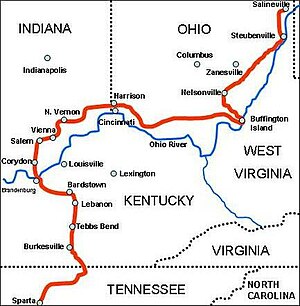Civil War Tuesdays
John Hunt Morgan (June 1, 1825 – September 4, 1864) was a flamboyant Confederate Civil War general, who used unconventional tactics and often made his own orders and rules. In June 1863 Morgan obtained permission from General Braxton Bragg to lead his men north, in an attempt to distract and divert Federal troops from joining in the Battle of Vicksburg. The public plan was to enter Kentucky, Morgan’s home state, and make Federals chase him, using valuable troops and supplies, thus increasing the margin of victory in Vicksburg.
From the beginning, Morgan had his own ideas, which he kept secret except for a few trusted staff, such as his brother-in-law, Basil Duke. Using his orders as an excuse, he planned to cross the Ohio River into Indiana, and raid north, possibly joining Lee at Gettysburg, which he assumed Lee would win.
Initially, his plan was successful. He did indeed divert troops and resources from Vicksburg and crossed into Indiana. In prior battles, Morgan curried goodwill with the populace and forbade his troops from looting. In this foray, he did not restrain them. After winning the battle at Corydon, where he outnumbered Lewis Jordan’s militia four to one, he permitted the troops to loot and pillage, to gain supplies for the continued offensive.

Morgan kept moving northeast, pretending to target Cincinnati. He’d sent one of his officers, Thomas Hines, north to find and negotiate with the local Copperheads, hoping for a groundswell of local support to help sustain the raid – but the support never came. Federal General Burnside mobilized to make sure Morgan couldn’t get back across the river. Morgan’s fallback plan was to melt into Kentucky. His secret weapon was a telegraph operator nicknamed “Lightning” Ellsworth, who tapped Federal telegraph lines, intercepted orders, and sometimes sent false messages to confuse the Federals.
Morgan’s gamble on Copperhead support not having paid off, and his men weary and diminished from fighting, the raid became a fight for survival. They worked their way north to Dupont, Indiana where they burned a warehouse and seized two thousand smoked hams. The daughter of the owner of the packing plant came out and gave the soldiers a tongue lashing. One private told her she looked beautiful when she was angry, and he would come back to marry her. Surprisingly, after the war, he did.
The raid continued, with soldiers sometimes spending sixty hours in the saddle without stopping, some sleeping while their horses followed the herd. They raided across southern Ohio, going north of Cincinnati, which Morgan knew he didn’t have the troops to take.

By mid-July 1863, Morgan’s troops arrived at Buffington Island, near the West Virginia border. He hoped to cross the river there, slow the pursuit of Federals, and fight north to Pennsylvania to join Lee. Then he got news of the defeat at Gettysburg. He had only two shells left for his Parrott rifles.
The local Ohio Militia threw up log breastworks and mounted a defense at the river. Morgan’s troops decided to halt for the night and rest up for the assault. He didn’t know how close Edward Hobson and the 13th Kentucky Infantry were on his rear. The militia melted away after dark, their delaying mission accomplished. Burnside requested naval support, and by morning, Federal gunboats had arrived on the river, shelling Morgan’s position, and blocking the crossing via Buffington Island. Hobson had his troops march double time and arrived that morning to harass Morgan’s rear. Chaos reigned as they were attacked from two directions. Desperately, they rode north, looking for another crossing. But more Federals arrived traveling toward them from the northwest. About half of Morgan’s force was captured in a deep ravine by the river (including William Dorsey Crump, my main character).
Morgan and the remainder of his troops fought along the river further north, finally reaching Salineville on July 26, 1863. Hobson had remained with the captured Confederates near Buffington. Federal General James Shackleford with a mixture of units from different commands continued the pursuit and caught Morgan at Salineville. Shackleford had about 2600 troops, to Morgan’s now greatly diminished eight hundred.
Morgan did not just rollover. With displays of bravery and horsemanship, they attempted to slash their way through but were eventually flanked and almost surrounded. They reached West Point, Ohio eight miles northeast of Salineville. His horses and men were exhausted. Rations had run out. There was little ammunition or powder left. When Morgan saw fresh troops between him and the river, he surrendered to one of his own Federal prisoners, Ohio Captain Burbridge. Burbridge, in gratitude for being left alive, immediately granted Morgan and his troops parole, which would have allowed them to return to Kentucky. But regular army Major Rue countermanded the paroles and insisted Morgan surrender to him. Thus ended the northernmost land battle with regular Confederate troops. Morgan was sent to Ohio penitentiary, where he later led a daring escape.
Some scholars quibble and say that the St. Albans, Vt. raid was the northernmost battle, but it was not with regular Confederate troops.
The Battle of Buffington Island is featured in Across the Great Divide: The Clouds of War, my Civil War novel.

HCC D Blog
Great reading your blogg